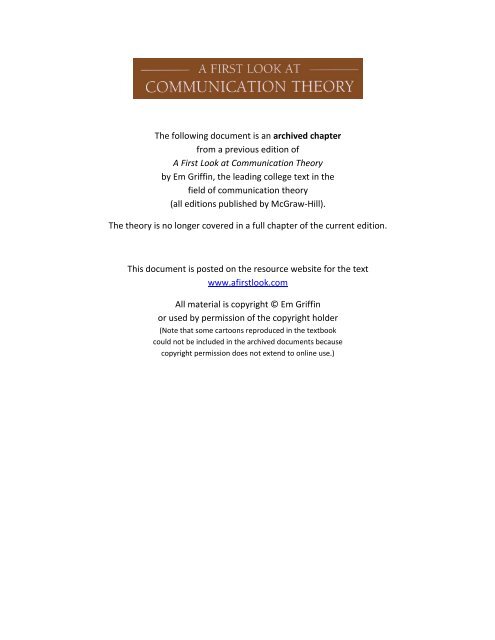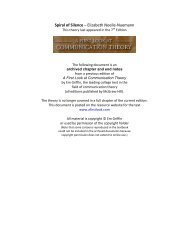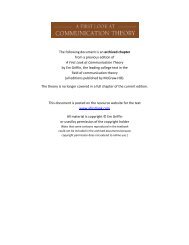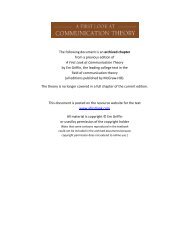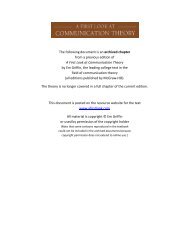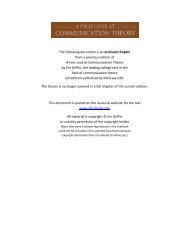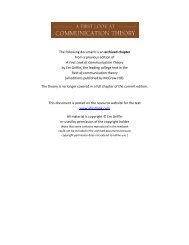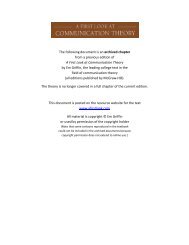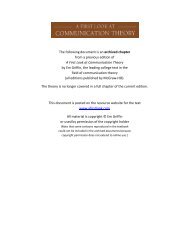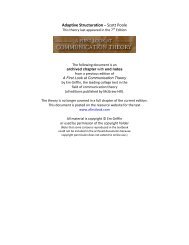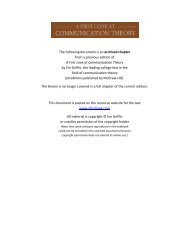Anxiety-Uncertainty Management Theory (PDF) - A First Look at ...
Anxiety-Uncertainty Management Theory (PDF) - A First Look at ...
Anxiety-Uncertainty Management Theory (PDF) - A First Look at ...
You also want an ePaper? Increase the reach of your titles
YUMPU automatically turns print PDFs into web optimized ePapers that Google loves.
CHAPTER 30: ANXIETY/UNCERTAINTY MANAGEMENT THEORY427Although I've included ADM in the section on intercultural communic<strong>at</strong>ion,Gudykunst intended his theory to apply in any situ<strong>at</strong>ion where differences betweenpeople spawn doubts and fears. For example, once a month I'm one of fourmen who cook breakfast, serve it, and clean up afterward <strong>at</strong> a local homelesscenter. I make it a point to talk with guests who show a desire for early morningconvers<strong>at</strong>ion, but I'm never sure wh<strong>at</strong> topics are appropri<strong>at</strong>e and I'm somewh<strong>at</strong>nervous about saying something th<strong>at</strong> will embarrass them (or me). Throughoutthe chapter I will use the terms intergroup and intercultural interchangeably to reflectthe scope of the theory and the fact th<strong>at</strong> we don't have to travel to a foreignland to either be-or encounter-a stranger.Gudykunst assumed th<strong>at</strong> <strong>at</strong> least one person in an intercultural encounter is astranger. 2 Through a series of initial crises, strangers experience both anxiety anduncertainty-they don't feel secure, and they aren't sure how to behave. Althoughstrangers and ingroup members experience some degree of anxiety and uncertaintyin any new interpersonal situ<strong>at</strong>ion, when the encounter takes place betweenpeople of different cultures, strangers are hyperaware of cultural differences. Theytend to overestim<strong>at</strong>e the effect of cultural identity on the behavior of people in analien society, while blurring individual distinctions ("When I was in the PhilippinesI noticed th<strong>at</strong> all Filipinos are ...").As a stranger in a strange land, I experienced all the thoughts and feelings th<strong>at</strong>Gudykunst describes. But lest we get hung up on our own doubts and insecurities,Gudykunst's words remind us th<strong>at</strong> my hosts <strong>at</strong> Mickelson were subject to thesame pangs of anxiety and uncertainty th<strong>at</strong> affected me. It was a novel situ<strong>at</strong>ionfor them as well-I was only the second Caucasian visitor they'd had <strong>at</strong> theirschool in a decade. As an outsider within their midst, my presence was a mixedblessing. By coming from afar, I affirmed their importance yet carried the baggageof foreign values. I was physically close but brought with me strange ways ofdoing things.Gudykunst made it clear th<strong>at</strong> ADM was always under construction. Early accountscast his ideas into cause-and-effect axioms written from the standpoint ofthe stranger. Recent efforts flip the perspective and describe intercultural encounterswith strangers as experienced by members of the ingroup. In an effort toavoid the ethnocentric trap of thinking th<strong>at</strong> my view of the world is the way it reallyis, I'll illustr<strong>at</strong>e Gudykunst's theory by applying it to the situ<strong>at</strong>ion of myPhilippine Belaan hosts. They wanted to bridge the culture gap through effectivecommunic<strong>at</strong>ion just as much as I did.EFFECTIVE COMMUNICATION: THWARTED BY ANXIETY AND UNCERTAINTYGudykunst uses the term effective communic<strong>at</strong>ion to refer to the process of minimizingmisunderstandings. He wrote th<strong>at</strong> "communic<strong>at</strong>ion is effective to the extentth<strong>at</strong> the person interpreting the message <strong>at</strong>taches a meaning to the messageth<strong>at</strong> is rel<strong>at</strong>ively similar to wh<strong>at</strong> was intended by the person transmitting it."3Other authors use a variety of terms to convey the same idea-accuracy, fidelity,mutual understanding. 4 According to Gudykunst, effective communic<strong>at</strong>ion between
428 CliLTUI,AL CONTEXTMickelson's president, Pol Quia, and me would not necessarily require th<strong>at</strong> wedraw close, share similar <strong>at</strong>titudes, or even speak with clarity-as welcome as theseoutcomes might be. Gudykunst would have considered our communic<strong>at</strong>ion effectiveif Pol and I could accur<strong>at</strong>ely predict and explain each other's behavior to theextent th<strong>at</strong> these actions tied into our discussion. In other words, no big surprises.Figure 30-1 diagrams Gudykunst's theory of anxietyI uncertainty management.5The theory is designed to explain how effective face-to-face communicaSelf-ConceptSocial identitiesPersonal identitiesCollective self-esteemf--Motiv<strong>at</strong>ion to InteractNeed for predictabilityNeed for group inclusionNeed to sustain self-conceptReactions to StrangersEmp<strong>at</strong>hyTolerance for ambiguityRigid intergroup <strong>at</strong>titudesf--f----<strong>Uncertainty</strong><strong>Management</strong>Social C<strong>at</strong>egoriz<strong>at</strong>ion of StrangersPositive expect<strong>at</strong>ionsPerceived personal similaritiesUnderstanding group differencesI-MindfulnessCommunic<strong>at</strong>ionEffectivenessSitu<strong>at</strong>ion ProcessesIngroup powerCooper<strong>at</strong>ive tasksPresence of ingroup membersConnections with StrangersAttraction to strangersInterdependence with strangersQuality and quantity of contactf----I-I<strong>Anxiety</strong><strong>Management</strong>IIEthical InteractionsMaintaining dignityMoral inclusivenessRespect for strangersf--MODERATINGSUPERFICIAL CAUSES BASIC CAUSES PROCESS OUTCOMEFIGURE 30-1A Schem<strong>at</strong>ic Represent<strong>at</strong>ion of AUM <strong>Theory</strong>(From Gudykunst, "An <strong>Anxiety</strong>/<strong>Uncertainty</strong> <strong>Management</strong> (AUM) <strong>Theory</strong> of Effective Communic<strong>at</strong>ion:Making the Mesh of the Net Finer.")
CHAPTER 30: ANXIETY/UNCERTAiNTY MANAGEMENT THEORY429tion is accomplished, and the box <strong>at</strong> the far right of the figure represents th<strong>at</strong> goal.Gudykunst said th<strong>at</strong> cutting down on misunderstanding is hard work, especiallywhen the stranger comes from a wildly different culture. As the title of his theorysuggests, and the figure depicts, he believed th<strong>at</strong> uncertainty and anxiety are thetwin thre<strong>at</strong>s th<strong>at</strong> must be managed to achieve effective communic<strong>at</strong>ion. They arethe basic cause of intercultural misunderstanding. Gudykunst's research showsth<strong>at</strong> anxiety and uncertainty usually go together/' yet he saw them as different inth<strong>at</strong> uncertainty is cognitive, whereas anxiety is affective-an emotion.Gudykunst formed his ideas of uncertainty based on Charles Berger's uncertaintyreduction theory (see Chapter 9). <strong>Uncertainty</strong> includes the doubts we haveabout our ability to predict the outcome of our encounters with strangers. For example,would my gift of an Encyclopaedia Britannica to the Mickelson library be regardedas an educ<strong>at</strong>ional treasure or an insensitive judgment on their lack of academicresources? In th<strong>at</strong> sense, uncertainty looks to the future.<strong>Uncertainty</strong> also includes doubts we have about the past. As we mentally reviewan intergroup encounter, we may be unable to explain why any of us acted aswe did. For example, why did students carry cases of Coke up the mountain whenI arrived <strong>at</strong> Mickelson? Was this effort in recognition of my st<strong>at</strong>us as honored visitor,an accommod<strong>at</strong>ion to my queasy North American stomach, or a tacit st<strong>at</strong>ementth<strong>at</strong> there would be nothing stronger to drink during my stay? I wasn't sure.<strong>Uncertainty</strong> is a thought; anxiety is a feeling. Gudykunst defined anxiety as"the feeling of being uneasy, tense, worried, or apprehensive about wh<strong>at</strong> mighthappen."7 Just as people fall silent when they fear th<strong>at</strong> their contrary opinionswill cause them to be isol<strong>at</strong>ed, so both strangers and ingroup members eye thefuture warily when their differences make mutual s<strong>at</strong>isfaction seem unlikely. Thedistrict superintendent expressed this form of fear the night before the Mickelsongradu<strong>at</strong>ion.I delivered a 40-minute address to students and their families <strong>at</strong> the seniorclassbaccalaure<strong>at</strong>e ceremony. Because most of the Belaan parents spoke no English,I stopped every few sentences for the superintendent to transl<strong>at</strong>e my wordsinto their tongue. Therefore, the 40 minutes consisted of 20 minutes of messageplus 20 minutes of interpret<strong>at</strong>ion. After I was through, the obviously worried mantook me aside and explained the local rhetorical facts of life. Wh<strong>at</strong> I had said wasfine, he told me, but it was way too brief. Unless I spoke <strong>at</strong> the gradu<strong>at</strong>ion ceremonythe next day for <strong>at</strong> least an hour-without an "interrupter"-the local citizenswould regard the ceremony as of little consequence and the students would"lose face." Now I was worried.The experience demonstr<strong>at</strong>es the extent to which anxiety and uncertainty arelinked to the degree of difference between the culture of the ingroup and the culturefrom which the stranger comes. Gudykunst's basic AUM model shown inFigure 30-1 doesn't portray the dimensions of cross-cultural variability as conceivedof by Geert Hofstede (see the introduction to this section). Yet 9 of the 47axioms th<strong>at</strong> Gudykunst laid out in AUM draw upon Hofstede's four dimensionsth<strong>at</strong> stake out cultural differences. The axioms make it clear th<strong>at</strong> the wider the gapbetween cultures, the higher the levels of anxiety and uncertainty all parties willtend to experience.
430 CULTUR,1L CONHXTThe book contains a Far Side cartoon here.Permission to reproduce the cartoon wasgranted for the original public<strong>at</strong>ion only anddoes not include reproduction in the online archive.According to Hofstede's research, the Philippines and the United St<strong>at</strong>es are almostidentical in their strong emphases on masculinity and high tolerance for ambiguity.HBut the two cultures diverge sharply on the dimension of power positionand collectivism versus individualism. I was an egalitarian individualist invadingthe world of hierarchical collectivists. No wonder they had some doubts and fearsto overcome when I arrived.Lower and Upper Thresholds for Fears and Doubts<strong>Anxiety</strong> and uncertainty aren't always bad. Gudykunst insisted th<strong>at</strong> a minimallevel of both are necessary to motiv<strong>at</strong>e us to communic<strong>at</strong>e better. If we feel ab
CHAPTEr, 30: ANXIETY/UNCERTAINTY MANAGElv!ENT THEORY431solutely no tension in an intergroup encounter, we may be bored and thus carelessabout wh<strong>at</strong> we say. The "Ugly American" stereotype is based on insensitive travelersfrom the United St<strong>at</strong>es who can't be bothered to monitor how they comeacross in other cultures. They'd be more effective if they were concerned about appearingprejudiced or seeming to be incompetent. Gudykunst said th<strong>at</strong> our minimumthreshold of anxiety is the least amount we can feel while still havingenough adrenaline running through our veins to prod us to communic<strong>at</strong>e effectively.In like manner, the minimum threshold of uncertainty is the "lowestamount of uncertainty we can have and not feel bored or overconfident about ourpredictions of strangers' behavior."9 If we're no longer curious about the stranger,we'll go on autom<strong>at</strong>ic pilot and likely misinterpret the words we hear.There comes a point where anxiety can be so gre<strong>at</strong> th<strong>at</strong> people become paralyzedwith fear. At this c<strong>at</strong>astrophic point, drastic changes are evident in the waypeople communic<strong>at</strong>e. Since they no longer can concentr<strong>at</strong>e on the message or themessenger, they fall back on neg<strong>at</strong>ive stereotypes or simply withdraw from theconvers<strong>at</strong>ion. When uncertainty reaches an upper threshold, people lose all confiderKeth<strong>at</strong> they can predict others' behavior, and communic<strong>at</strong>ion no longer seemsworthwhile. AUM postul<strong>at</strong>es th<strong>at</strong> effective communic<strong>at</strong>ion is possible only whenparticipants' levels of anxiety and uncertainty fall somewhere between thoseupper and lower thresholds. Within th<strong>at</strong> middle range, if we mindfully reducethese two basic causes of misunderstanding, Gudykunst assured us th<strong>at</strong> we'll becomemore effective intergroup communic<strong>at</strong>ors.MINDFULNESS: CONSCIOUS CHOICE RATHER THAN SCRIPTED BEHAVIORAccording to AUM, mindfulness is the way th<strong>at</strong> ingroup members and strangerscan reduce their anxiety and uncertainty to optimum levels. It's the opposite ofbeing mindless. Our talk is mindless when we follow a set convers<strong>at</strong>ional routine.The way we answer the phone, place an order <strong>at</strong> McDonald's, or kid around withour friends becomes so habitual th<strong>at</strong> we can do it without thinking. Someonew<strong>at</strong>ching us play out our lives could easily spot a number of scripts we seem tofollow when we communic<strong>at</strong>e with others.Scripted behavior may serve us well when the roles are familiar and all theplayers know their lines, but Gudykunst cautioned th<strong>at</strong> mindless convers<strong>at</strong>ion ina cross-cultural situ<strong>at</strong>ion can escal<strong>at</strong>e the tension and confusion th<strong>at</strong> already arethere. In order to reduce anxiety and uncertainty r<strong>at</strong>her than cre<strong>at</strong>e more, Pol Quianeeds to pay <strong>at</strong>tention to wh<strong>at</strong> he says and how I respond. I need to monitor mywords and Pol's reaction as well.William Howell, one of Gudykunst's mentors <strong>at</strong> the University of Minnesota,suggests four levels of communic<strong>at</strong>ion competence: 101. Unconscious incompetence. We misinterpret others' behavior and aren't evenaware we're doing so. Ignorance is bliss.2. Conscious incompetence. We know th<strong>at</strong> we're misinterpreting others' behaviorbut don't do anything about it.
432 CULTURAL CONTEXT3. Conscious competence. We think about our communic<strong>at</strong>ion and continuallywork <strong>at</strong> changing wh<strong>at</strong> we do in order to become more effective.4. Unconscious competence. We've developed our communic<strong>at</strong>ion skills to thepoint where we no longer have to think about how we speak or listen.Gudykunst defined mindfulness as Stage 3 in Howell's model. In fact, followingHarvard psychologist Ellen Langer's notion of mindful learning. he thoughtStage 4 is less competent than Stage 3 and can be downright dangerous. 11 Someoneoper<strong>at</strong>ing <strong>at</strong> th<strong>at</strong> level may look and feel like a "n<strong>at</strong>ura!," but situ<strong>at</strong>ions withstrangers are often so fluid th<strong>at</strong> unconscious competence can quickly turn intooblivious incompetence.Langer suggests th<strong>at</strong> being mindful involves the cre<strong>at</strong>ion of new c<strong>at</strong>egoriesr<strong>at</strong>her than simply classifying people according to their ethnicity, gender, age,wealth, or roles. The process is akin to Delia's description of cognitively complexpersons using a rich number of interpersonal constructs when they form their impressionsof others (see Chapter 13). Langer also st<strong>at</strong>es th<strong>at</strong> mindfulness meansbeing open to new inform<strong>at</strong>ion and recognizing th<strong>at</strong> the other person may have adifferent perspective than we do. Gudykunst agreed but said th<strong>at</strong> most peoplerarely do it. "The vast majority of the time (i.e., when we are not mindful), we interpretstrangers' messages using our own frames of reference and they interpretour messages using their frames of reference."12Throughout this book I've identified theories according to their objective or interpretiveassumptions. In Chapter 1, I st<strong>at</strong>ed th<strong>at</strong> objectivist theorists see people asshaped by outside forces, whereas interpretive theorists emphasize our freedom ofchoice. Gudykunst said both positions are right <strong>at</strong> different times, depending onour mindset. He believed th<strong>at</strong> objectivist assumptions hold when we aren't mindful.For most of the time our behavior is strongly influenced by our culture, groupmemberships, environmental forces, and situ<strong>at</strong>ional factors. But he was convincedth<strong>at</strong> interpretive assumptions of human n<strong>at</strong>ure are correct when we are mindful.At these significant moments we are free to think in new ways and can consciouslychoose to act uncharacteristically-to break out of scripted behavior.The interpretive right side of Figure 30-1 reflects Gudykunst's conviction th<strong>at</strong>ingroup members and strangers have the potential to manage and moder<strong>at</strong>e theiranxiety and uncertainty-the basic causes of poor intercultural communic<strong>at</strong>ion.To the extent th<strong>at</strong> they are mindfully <strong>at</strong>tentive to the process, their communic<strong>at</strong>ioncan be effective. I believe three of the Mickelson faculty couples made consciousefforts to negoti<strong>at</strong>e joint meanings and cre<strong>at</strong>e mutual understandings with meduring my first weeklong visit. Th<strong>at</strong>'s why I've returned to Davao del Sur fourtimes over the last two decades.CAUSES OF ANXIETY AND UNCERTAINTY IN INTERCULTURAL ENCOUNTERSThe objective left side of Figure 30-1 pulls together many factors th<strong>at</strong> typicallycause uncertainty and anxiety to rise or fall in intercultural encounters. Don't letGudykunst's label of Superficial Causes fool you into thinking they are unimpor
CHAPTER 30: ANXIETY/UNCERTAINTY MANACEMENT THEORY433tant. They are superficial only in the sense th<strong>at</strong> they are the surface factors th<strong>at</strong>contribute to the underlying issues of anxiety and uncertainty in intergroup communic<strong>at</strong>ion.Thirty-nine of ADM's 47 axioms present cause-and-effect linkages tothe fear and confusion th<strong>at</strong> usually occur when cultures clash. I'll present 10 ofthese axioms th<strong>at</strong> I've found especially helpful in understanding my initial encounterwith the indigenous Filipino faculty and students <strong>at</strong> Mickelson College.As you'll see, the axioms draw heavily on ideas advanced by other communic<strong>at</strong>iontheorists. In th<strong>at</strong> sense, ADM provides a gre<strong>at</strong> review of much th<strong>at</strong> you've alreadyread in earlier chapters.All of Gudykunst's axioms contain boundary conditions th<strong>at</strong> specify whenthe causal rel<strong>at</strong>ionship holds true or when it doesn't apply. For each of these 10,the scope is the same:Boundary condition: This axiom holds only when our anxiety and uncertainty arebetween our minimum and maximum thresholds, and we are not mindful.l'In other words, this is how intergroup anxiety and uncertainty are usually cre<strong>at</strong>edand allevi<strong>at</strong>ed, but when fear and confusion are almost nonexistent or extremelyhigh, the rules of the game change and all bets are off. Also, mindfulness trumpsthese causal p<strong>at</strong>terns. While keeping these exceptions in mind, consider the following10 predictions.Self-ConceptAxiom 3: An increase in our self-esteem when interacting with strangers will producea decrease in our anxiety and an increase in our ability to predict their behavioraccur<strong>at</strong>ely.Mead's symbolic interactionism suggests th<strong>at</strong> our self-image is formed by theway we see others regarding us-the looking-glass self (see Chapter 4). Because oftheir poverty, ethnic origin, and religious convictions, this Belaan community waslooked down on by other people of Davao del Sur. During my weeklong stay, theyrepe<strong>at</strong>edly voiced their surprise th<strong>at</strong> I would go out of my way to be with them.Hopefully, my sincere admir<strong>at</strong>ion for their warmth, faith, courage, and resourcefulnesswas one small pebble on the scale of self-esteem. But Axiom 3 predicts th<strong>at</strong>they could have a tough time dealing with any anxiety th<strong>at</strong> my visit aroused.Motiv<strong>at</strong>ion to InteractAxiom 9: An increase in our confidence in our ability to predict strangers' behaviorwill produce a decrease in our anxiety; a decrease in our anxiety will produce anincrease in our confidence in predicting strangers' behavior.Because I try to write in a personal voice, Mickelson faculty and staff who hadread my text already had preconceptions of my personality and how I'd act. Fortun<strong>at</strong>ely,there was a m<strong>at</strong>ch between their anticip<strong>at</strong>ion and who I turned out to bein person. I repe<strong>at</strong>edly heard the comment "You're just like you are in the book."
434 CULTURAL CONTEXTSince I value the congruence th<strong>at</strong> Carl Rogers advoc<strong>at</strong>es (see Chapter 2), I gre<strong>at</strong>lyappreci<strong>at</strong>ed their words. My hosts seemed to take equal delight in the fact th<strong>at</strong> theirforecast was accur<strong>at</strong>e. After the first day they became more <strong>at</strong> ease when we talked.Reactions to StrangersAxiom 10: An increase in our ability to process inform<strong>at</strong>ion complexly aboutstrangers will produce a decrease in our anxiety and an increase in our ability topredict their behavior accur<strong>at</strong>ely.Delia's constructivism assumes th<strong>at</strong> cognitively complex people are bestequipped to take the perspective of others (see Chapter 13). As I talked with BingQuia, the wife of Mickelson's president, she showed th<strong>at</strong> she didn't think of peoplein either/ or c<strong>at</strong>egories. Perhaps her interpersonal flexibility was due to herwider knowledge of Filipino society-she was the only adult <strong>at</strong> the school whowasn't Belaan by birth. Wh<strong>at</strong>ever the reason for her ability to differenti<strong>at</strong>e personalityconstructs, Bing seemed to be able to sense my thoughts and feelings andexpress them to others in the group.Axiom 13: An increase in our tolerance for ambiguity will produce a decrease in ouranxiety.Given the slow pace of life in a remote setting without telephone, television,or daily mail, students <strong>at</strong> Mickelson found it difficult to understand my concernabout returning to Manila on a specific day. After a few questions, however, theyseemed to accept this stranger's preoccup<strong>at</strong>ion with schedule as a puzzle notworth worrying about. Even though I was the visitor to their culture, I sensed th<strong>at</strong>they were compiling a "thick description" of my cultural values without havingto make immedi<strong>at</strong>e sense of wh<strong>at</strong> they observed (see Chapter 20).Social C<strong>at</strong>egoriz<strong>at</strong>ion of StrangersAxiom 17: An increase in the personal similarities we perceive between ourselves andstrangers will produce a decrease in our anxiety and an increase in our ability toaccur<strong>at</strong>ely predict their behavior.Burke used the term identific<strong>at</strong>ion to refer to the similarities t 1 <strong>at</strong> make interpersonalcommunion possible (see Chapter 23). Despite our cultur..1, ethnic, and socioeconomicdifferences, the teachers <strong>at</strong> Mickelson and I shared a concern for qualityeduc<strong>at</strong>ion with a desire to be involved with students outside the classroom. We alsowere parents of children approxim<strong>at</strong>ely the same age. As if these similarities didn'tprovide enough common ground, I was shipwrecked with the district superintendentin a violent thunderstorm. Th<strong>at</strong> life-thre<strong>at</strong>ening experience together madethoughts of stranger-danger recede and drew us together in a common bond.Axiom 20: An increase in perceiving th<strong>at</strong> we share superordin<strong>at</strong>e ingroup identitieswith strangers will produce a decrease in our anxiety and an increase in our abilityto predict their behavior accur<strong>at</strong>ely.
CHAPTER jO: ANXiETY/UNCERTAiNTY MANAGEMENT THEOR1'435Superordin<strong>at</strong>e values or goals are those th<strong>at</strong> trump lesser important identities,As members of a faith-based school in the Philippines th<strong>at</strong> shared the same religiouscommitment as my college in the United St<strong>at</strong>es, they rightly assumed th<strong>at</strong> weshared a tie th<strong>at</strong> bound us together, Mickelson is a Christian school in a Muslimarea of Mindanao; no credential th<strong>at</strong> I possessed was more important to my Filipinohosts than our common faith. I assume th<strong>at</strong> religion would also have been a superordin<strong>at</strong>eissue for any stranger who came to the Islamic school across the valley.Situ<strong>at</strong>ional ProcessesAxiom 26: An increase in the power we perceive th<strong>at</strong> we have over strangers willproduce a decrease in our anxiety and a decrease in the accuracy of our predictionsof their behavior.As a guest in an isol<strong>at</strong>ed community, I was completely dependent on my hostsfor food, shelter, inform<strong>at</strong>ion about the surrounding area, and the schedule ofdaily activities. They seemed to enjoy this control and I faced resistance when Itried to discover wh<strong>at</strong> they had planned for the next day. Afraid th<strong>at</strong> I'd never getoff campus, I went exploring on my own before breakfast. My hosts were horrified.Didn't I know it was dangerous to be in the jungle on my own? They shooktheir heads in dismay. Wh<strong>at</strong> would I be doing next?Connections with StrangersAxiom 27: An increase in our <strong>at</strong>traction to strangers will produce a decrease in ouranxiety and an increase in our confidence in predicting their behavior.At the end of my visit, Pol told me th<strong>at</strong> our rel<strong>at</strong>ionship was solidified withlaughter. It started when I was afraid of crossing a ravine on a felled coconut tree,so I crawled across on all fours like an animal. The Belaans began to giggle <strong>at</strong> theridiculous sight, and I couldn't help laughing with them. After th<strong>at</strong>, whenever theconvers<strong>at</strong>ion got dull, someone would grunt like a pig and we'd all break outlaughing. As social penetr<strong>at</strong>ion theory predicts, <strong>at</strong>traction led to vulnerability andself-disclosure (see Chapter 8).Axiom 31: An increase in networks we share with strangers will produce a decreasein our anxiety and an increase in our ability to accur<strong>at</strong>ely predict their behavior.This axiom is a direct extension of the one Berger added to his original uncertaintyreduction theory (see Chapter 9). Ping and Lena, my former gradu<strong>at</strong>e students,were the only people the Mickelson staff and I knew in common, but theyacted as enthusiastic go-betweens as they both sponsored me and endorsed myhosts.Ethical InteractionsAxiom 34: An increase in our moral inclusiveness toward strangers will produce adecrease in our anxiety.
436 CULTURAL CONTEXTAs I bel<strong>at</strong>edly discovered, I committed a number of blunders th<strong>at</strong> had moralimplic<strong>at</strong>ions in this remote Philippine community. I failed to e<strong>at</strong> everything th<strong>at</strong>Bing served, I used more than a bucket of fresh w<strong>at</strong>er for my sponge b<strong>at</strong>h, and Iembarrassed the Mickelson faculty when I asked them to tell me about the problemsthey had in their school. Yet they gave me a "visitor's pass," not blamingme for my insensitivity. As one "cultural informant" l<strong>at</strong>er told me, "We didn'tjudge you, because we wanted to make sure th<strong>at</strong> you didn't judge us. It was betterth<strong>at</strong> way."These 10 examples provide a sample of the multiple factors th<strong>at</strong> Gudykunstclaimed affect the anxiety and uncertainty th<strong>at</strong> people experience when a strangercomes into their midst. The continual tie-in with other communic<strong>at</strong>ion theory andresearch demonstr<strong>at</strong>es Gudykunst's belief th<strong>at</strong> intercultural communic<strong>at</strong>ion is anextension of, r<strong>at</strong>her than an exception to, principles of interpersonal communic<strong>at</strong>ion.It's all a m<strong>at</strong>ter of degree. The stranger a stranger is, the more everyone involvedhas to work mindfully <strong>at</strong> overcoming anxiety and uncertainty.CRITIQUE: REFLECTIONS ON THE CHOICES THAT GUDYKUNST MADEYou may remember th<strong>at</strong> Michael Sunnafrank is a severe critic of uncertainty reductiontheory-the theory th<strong>at</strong> was the original c<strong>at</strong>alyst for ADM (see Chapter 9).Yet Sunnafrank acknowledges the impact and scope of Gudykunst's work: "unarguablythe most prolific communic<strong>at</strong>ion research program in the 1980s is beingconducted by Gudykunst and his associ<strong>at</strong>es."14 This flow of scholarship continueduntil his de<strong>at</strong>h; he was constantly revising and extending the applic<strong>at</strong>ion of histheory.There is a danger, however, th<strong>at</strong> the student of communic<strong>at</strong>ion could easily beoverwhelmed by the sheer quantity and detail of Gudykunst's theoretical predictions.I find it hard to get my arms around 34 variables th<strong>at</strong> are linked to anxietyand uncertainty, and then to another 13 th<strong>at</strong> layout the rel<strong>at</strong>ionships among anxiety,uncertainty, mindfulness, effective communic<strong>at</strong>ion, and cross-cultural variability.Gudykunst acknowledged the large number of axioms, but he didn't regard themas excessive for a theory th<strong>at</strong> aims <strong>at</strong> clarity and usefulness: "I il1.clude a sufficientnumber of st<strong>at</strong>ements to make anxiety/uncertainty manageIT' :,~ processes clearto readers who may want to apply the theory to improve their communic<strong>at</strong>ioneffictiveness."15In the final section of the book I discuss the compromises or "trade-offs" eachtheorist must make when constructing a theory. No theory can do it all. Gudykunstmade a conscious choice to cre<strong>at</strong>e a theory in the "grand" tradition-a theory th<strong>at</strong>addresses a vast array of communic<strong>at</strong>ion variables in a variety of communic<strong>at</strong>ioncontexts. He then decided to cast his conclusions in specific axioms th<strong>at</strong> are easilyapplied. One has to admire the ambitious scope of the project. Wh<strong>at</strong> he sacrificed,of necessity, is simplicity. As you can tell by the way I've set up this chapter, it's not
CHAPTER 30: ANXIETY/UNCERTAINTY MANAGEMENT THEORY437a choice I would have made. Instead of listing the 47 axioms, I decided to illustr<strong>at</strong>esome and summarize a few. But as a serious student of communic<strong>at</strong>ion theory andpractice, I'm glad Gudykunst and some others think big.I'm also intrigued with Gudykunst's solution to the age-old dilemma concerningfree will and determinism. Most theorists either explicitly or tacitly planttheir flag somewhere on the continuum between the two extremes, but neitherthey nor their readers seem particularly comfortable with their selection. In wh<strong>at</strong>I regard as a potentially brilliant move, Gudykunst made it possible to embraceboth sides of the scale. Each of his axioms is conditional on whether or not ingroupmembers engage in mindful interaction. When they don't, their behavior is determined-or<strong>at</strong> least quite predictable. When they do, they are freed up to act innovel ways. For empirically minded researchers (like Gudykunst), the problemwith this solution is th<strong>at</strong> there isn't yet any procedure to measure when people arebeing mindful, so there's no way to test his assumption. And as Cudykunst acknowledged,"A method for assessing our minimum and maximum thresholdsfor anxiety and uncertainty has not been developed."J6 Without being able tomeasure the theory's most important variables, it's hard to test it or apply it withconfidence in specific situ<strong>at</strong>ions.Stella Ting-Toomey, Gudykunst's colleague <strong>at</strong> California St<strong>at</strong>e University,Fullerton, questions whether the whole uncertainty reduction approach reflects aWestern bias. She notes th<strong>at</strong> the implicit goal of uncertainty reduction is to controlone's environment-a theme th<strong>at</strong> is "highly valued by Western, individualistic culturesbut not necessarily by Eastern, collectivistic cultures."l7 Gudykunst stronglyobjected, noting th<strong>at</strong> according to Geert Hofstede's list, most Asian countries arehigh on uncertainty avoidance. (See the introduction to this section.)But the issue Ting-Toomey raises is more far-reaching than the rel<strong>at</strong>ive importanceof reducing uncertainty. Wh<strong>at</strong>'s <strong>at</strong> stake is the question of whether or nota pan-human theory of intercultural communic<strong>at</strong>ion is possible.1 8 You'll have achance to consider the issue of compar<strong>at</strong>ive theory and East-West differenceswhen you read about Ting-Toomey's face-negoti<strong>at</strong>ion theory in the next chapter.QUESTIONS TO SHARPEN YOUR FOCUS1. When might the reduction of anxiety and uncertainty hinder r<strong>at</strong>her than helpfacilit<strong>at</strong>e effective communic<strong>at</strong>ion?2. Which of the 10 superficial causes of anxiety and uncertainty th<strong>at</strong> I presentedwould apply to communic<strong>at</strong>ion between teenagers and the elderly? Would theybe different for encounters between heterosexuals and homosexuals?3. Can you think of situ<strong>at</strong>ions where mindfulness might hinder r<strong>at</strong>her than helpeffective communic<strong>at</strong>ion?4. Think of the most culturally diverse intercultural encounter you've ever had.Which of Hofstede's four dimensions of cultural variability were highly discrepant?
438 CULTUlU1L CCJNTEX7SELF-QUIZFor chapter self-quizzes go to the book's Online Learning Center <strong>at</strong>www.l1Ilzlze.com/grifjil/6A SECOND LOOKRecolllllll'rtded resource: William B. Gudykunst, "An <strong>Anxiety</strong>/<strong>Uncertainty</strong> <strong>Management</strong>(AUM) <strong>Theory</strong> of Effective Communic<strong>at</strong>ion: Making the Mesh of the Net Finer," in TheorizingAbout Intercultural COllll11unic<strong>at</strong>ion, William B. Gudykunst (ed.), Sage, Thousand Oaks,CA, 2005, pp. 281-332.Earlier version: William B. Gudykunst, "<strong>Anxiety</strong>I<strong>Uncertainty</strong> <strong>Management</strong> (AUM)<strong>Theory</strong>: Current St<strong>at</strong>us," in Intercultural Coml11U1zic<strong>at</strong>irn <strong>Theory</strong>, R. L. Wiseman (ed.), Sage,Thousand Oaks, CA, 1995, pp. 8-58.<strong>First</strong> formal st<strong>at</strong>ement ofAUM: William B. Gudykunst, "Toward a <strong>Theory</strong> of Effective Interpersonaland Intergroup Communic<strong>at</strong>ion: An <strong>Anxiety</strong>I <strong>Uncertainty</strong> <strong>Management</strong>(AUM) Perspective," in Intercultural Communic<strong>at</strong>ion Competence, R. L. Wiseman and J.Koester (eds.), Sage, Newbury Park, CA, ]993, pp. 33-71.Empirical support: William B. Gudykunst and Tsukasa Nishida, "<strong>Anxiety</strong>, <strong>Uncertainty</strong>,and Perceived Effectiveness of Communic<strong>at</strong>ion Across Rel<strong>at</strong>ionships and Cultures," Intern<strong>at</strong>ionalJournal tf Intercultural Rel<strong>at</strong>ions, Vol. 25, 2001, pp. 55-71.Gudykllllst's parallel theory of intercultural adjustment: William B. Gudykunst, "An<strong>Anxiety</strong>I <strong>Uncertainty</strong> <strong>Management</strong> (AUM) <strong>Theory</strong> of Strangers' Intercultural Adjustment,"in Theorizing About Intercultural COllll/llInic<strong>at</strong>ion, William B. Gudykunst (ed.), Sage, ThousandOaks, CA, 2005, pp. 419-457.Overview t:f intercultural theories: William B. Gudykunst, "Intercultural Communic<strong>at</strong>ionTheories," in Handbrok of Intern<strong>at</strong>ional and Intercultural Commullic<strong>at</strong>ion, William B.Gudykunst and Bella Mody (eds.), Sage, Thousand Oaks, CA, 2002, pp. 207-224.Interpersonal [1S. intergroup rel<strong>at</strong>ions: William B. Gudykunst and Robin Shapiro, "Communic<strong>at</strong>ionin Everyday Interpersonal and Intergroup Encounters," Intern<strong>at</strong>iollal JoumallfIntercultural Rel<strong>at</strong>ions, Vol. 20, 1996, pp. 19-45.Mindfulness: Ellen J. Langer, The Power of Min dfll I Learning, Add' _Jl1-Wesley, Reading,MA,1997.Practical applic<strong>at</strong>ion of theory: William B. Gudykunst, Bridging Differences: Effective IntergroupCommunic<strong>at</strong>ion, 4 tb ed., Sage, Thousand Oaks, CA, 2003.Critique: Stella 'Ting-Toomey, "Culture and Interpersonal Rel<strong>at</strong>ionship Development:Some Conceptual Issues," in Communic<strong>at</strong>ion Yearbook 15, James A. Anderson (ed.), Sage,Newbury Park, CA, 1989, pp. 371-382.


